What an impressive achievement for a woman who, at first, was very reluctant to embark on a Hollywood career, as she thought that, as a swimmer, she had no requirement to become a movie celebrity.
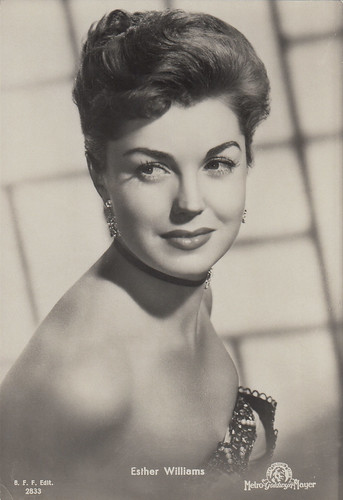
Italian postcard by B.F.F. Edit. (Ballerini & Fratini, Firenze), no. 2833. Photo: Metro-Goldwyn-Mayer. Collection: Marlene Pilaete.
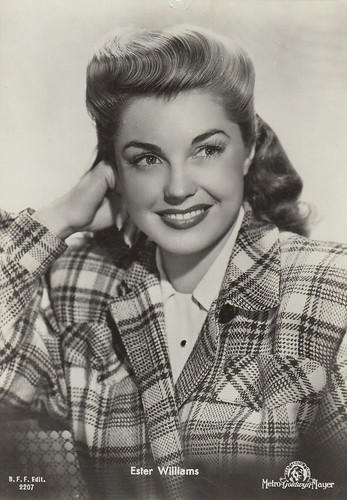
Italian postcard by B.F.F. Edit. (Ballerini & Fratini, Firenze), no. 2207. Photo: Metro-Goldwyn-Mayer. Collection: Marlene Pilaete.
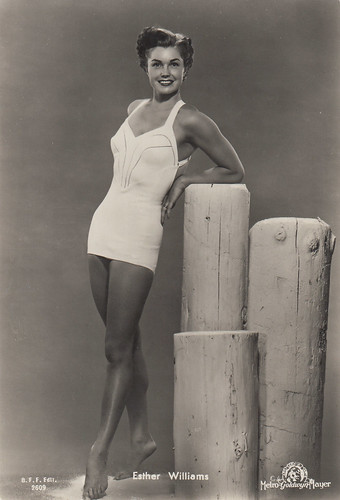
Italian postcard by B.F.F. Edit. (Ballerini & Fratini, Firenze), no. 2609. Photo: Metro-Goldwyn-Mayer. Collection: Marlene Pilaete.

Italian postcard by Bromofoto, Milano, no. 236. Collection: Marlene Pilaete.

Vintage postcard. Photo: M.G.M. Esther Williams in Pagan Love Song (Robert Alton, 1950). Collection: Marlene Pilaete.
A passion for swimming
Esther Williams was born on the 8th of August 1921 in Inglewood, California, USA.
At the beginning of the 1930s, she learned to swim, took an immediate liking to it, and soon began competing in swim meets. At the end of the decade, she was a renowned champion and had several national records to her name.
As a member of the prestigious Los Angeles Athletic Club, she won three gold medals in the 100-meter freestyle, the 4 x 100-meter relay, and the 300-meter medley relay at the 1939 US swimming championships.
She soon began to train for the 1940 Olympics but they were cancelled due to World War II.
Fortunately, the producer Billy Rose hired her in 1940 for his San Francisco Aquacade, a spectacular water show in which she shared the spotlight with Johnny Weissmuller. She was spotted by a talent scout and signed a contract with M.G.M. in 1941.

French postcard by Editions E.P.I., Paris, no. 14F. Collection: Marlene Pilaete.

Swedish "Serga Colour" postcard by Forlag Torsten G. Erison, Hälsingborg, no. A.X. 1164. Esther Williams in Million Dollar Mermaid (Mervyn LeRoy, 1952). Collection: Marlene Pilaete.
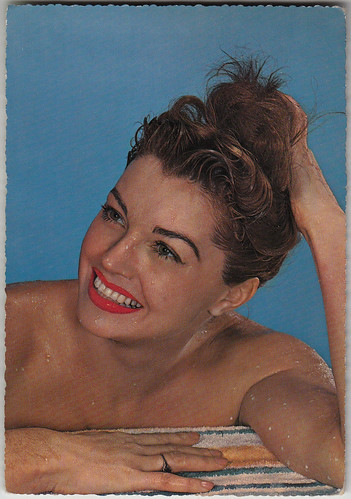
German postcard by Kruger, no. 902/9. Collection: Marlene Pilaete.
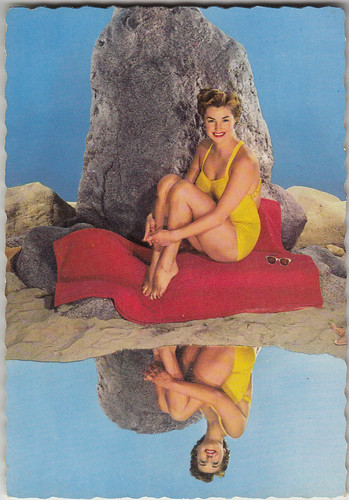
Italian postcard by Rotalcolor, Milano, no. 94. Collection: Marlene Pilaete.
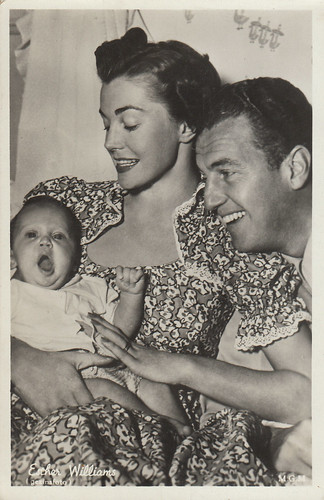
Belgian postcard by Nieuwe Merksemsche Chocolaterie S.P.R.L., Merksem Anvers. Esther Williams and Ben Gage with their son Benjamin. Collection: Marlene Pilaete.
The M.G.M. mermaid
She made her film debut in Andy Hardy’s Double Life (George B. Seitz, 1942), in which she gave an underwater kiss to Mickey Rooney, played a young housewife in the wartime propaganda short Inflation (Cy Endfield, 1943), and had a supporting role in A Guy Named Joe (Victor Fleming, 1943).
After these first steps in the movie world, M.G.M. eventually felt she was ready for star treatment and made the best use of her swimming skills and engaging personality in Bathing Beauty (George Sidney, 1944), which made her hot property. The aqua-musical genre was successfully launched. She followed Bathing Beauty with a leading role as a swimming instructor in Thrill of a Romance (Richard Thorpe, 1945) and a featured nautical ballet in Ziegfeld Follies (Vincente Minnelli, 1945).
M.G.M. then choose to test her acting talents in the drama The Hoodlum Saint (Norman Taurog, 1946) and in the musical romance Easy to Wed (Edward Buzzell, 1946). In Fiesta (Richard Thorpe, 1947), an unplausible plot had her play matador Ricardo Montalban’s twin sister, who replaces her brother in bullfighting. She only swam very briefly and was somewhat overshadowed by her male co-star and by Cyd Charisse, who had nice dancing scenes together. These three movies were not the best showcases to her talents and M.G.M. wisely decided that Esther had to be put back into the water in This Time for Keeps (Richard Thorpe, 1947) and On an Island with You (Richard Thorpe, 1948), which were much more suited to her special gifts.
In 1949 came the musical Take Me Out to the Ball Game (Busby Berkeley, 1949) with Gene Kelly and Frank Sinatra as co-stars. She only had a brief swimming scene in it and later declared that she was unhappy during filming, as she felt that Gene Kelly and Stanley Donen treated her with contempt. Anyway, it was a big success. Her following films were much closer to what the public was expecting from Esther Williams movies and were enhanced by water sequences which filled her fans with joy.
She starred in Neptune’s Daughter (Edward Buzzell, 1949), Duchess of Idaho (Robert Z. Leonard, 1950), Pagan Love Song (Robert Alton, 1950), Texas Carnival (Charles Walters, 1951), Skirts Ahoy! (Sidney Lanfield, 1952), Million Dollar Mermaid (Mervyn LeRoy, 1952), which was based upon the life of swimming star Annette Kellermann, Dangerous When Wet (Charles Walters, 1953), and Easy to Love (Charles Walters, 1953).
In 1949 and 1950, she was one of the ten most popular stars at the U.S . box office and, in 1952, she was awarded the "World Female Film Favourite" Henrietta Award. In 1955, Jupiter’s Darling (George Sidney, 1955) flopped. The times were changing and the vogue of aqua-musicals was coming to an end.
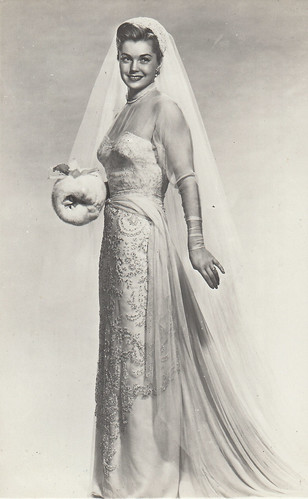
Spanish postcard, no. 4957. Collection: Marlene Pilaete.

Spanish postcard by Soberanas, Barcelona, no. 491. Collection: Marlene Pilaete.

Vintage postcard. Collection: Marlene Pilaete.
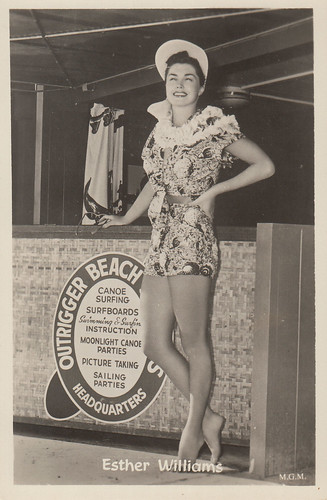
Vintage postcard. Photo: M.G.M. Collection: Marlene Pilaete.

Spanish postcard, no. 1003. Esther Williams and Red Skelton in Bathing Beauty (George Sidney, 1944). Collection: Marlene Pilaete.
The end of her performing career
Esther Williams left M.G.M. and was featured in the thriller The Unguarded Moment (Harry Keller, 1956), the steamy drama Raw Wind in Eden (Richard Wilson, 1958), both for Universal, and in The Big Show (James B. Clark, 1961) for A.P.I. These three straight roles didn’t stop her movie career’s decline.
She had more luck on television in two NBC specials: The Esther Williams Aqua Spectacle in 1956 and Esther Williams at Cypress Gardens in 1960. Billed as the "Water Queen of the World", she also starred in a water show in London in 1956.
She disappeared from the screen after La fuente magica/Magic Fountain (1963), directed in Spain by Fernando Lamas, who became her third husband and who urged her to retire from public life.
Before Fernando Lamas, she had married Leonard Kovner, a medical student, in 1940 and had divorced him in 1944. She then became radio announcer Ben Gage’s wife in 1945 and had three children. He spent a large part of her fortune and they were divorced at the end of the 1950s.
Fernando Lamas passed away in 1982 and Williams remarried for the last time with Edward Bell, with whom she lived out the rest of her life.

Spanish postcard by Archivo Bermejo, no. 4690. Esther Williams and Ricardo Montalban in Neptune’s Daughter (Edward Buzzell, 1949). Collection: Marlene Pilaete.
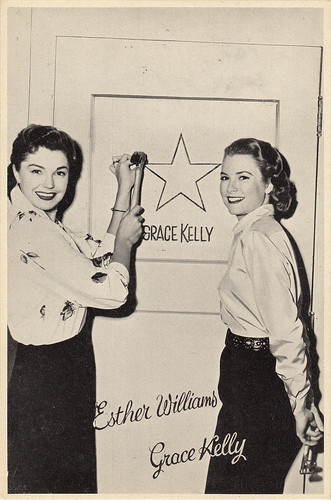
Vintage postcard. Esther Williams and Grace Kelly. Grace inherited Esther’s M.G.M. dressing room when the famous swimmer left the company. Collection: Marlene Pilaete.

Dutch postcard by Takken, no. A.X. 528. Photo: Metro-Goldwyn-Mayer. Collection: Marlene Pilaete.

Dutch postcard by Foto Archief Film en Toneel, no. 3213. Photo: Metro Goldwyn Mayer. Collection: Marlene Pilaete.

Dutch postcard by Foto Archief Film en Toneel, no. ax 202. Photo: Metro-Goldwyn-Mayer. Collection: Marlene Pilaete.
Esther’s comeback
After Fernando Lamas’ death, Esther Williams came out of her retirement.
When synchronized swimming became an Olympic sport at the Los Angeles Games in 1984, she served as a commentator for NBC Sports Channel. That same year, she produced an instructional video called Swim Baby, Swim in which she gave advice to parents who wanted to teach their young children to swim.
In 1994, she was one of the hosts of the compilation movie That’s Entertainment III (Bud Friedgen, Michael J. Sheridan, 1994) and, in 1999, her autobiography was published, 'The Million Dollar Mermaid: An Autobiography'.
Esther Williams passed away on the 6th of June 2013 in Beverly Hills, California. She was 91.

Vintage postcard. Esther Williams holding the Henrietta Award she received in 1952. Collection: Marlene Pilaete.
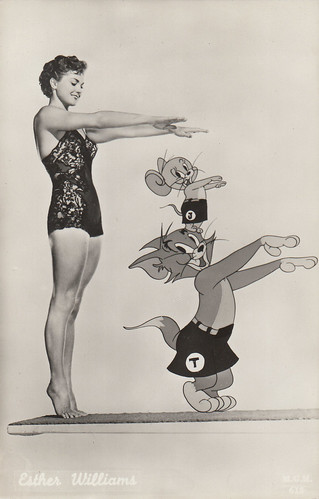
Vintage postcard, no. 615. Photo: M.G.M. Esther Williams swam with Tom and Jerry in Dangerous When Wet (Charles Walters, Joseph Barbera (animation sequences), William Hanna (animation sequences), 1953). Collection: Marlene Pilaete.

Vintage postcard. Photo: M.G.M. Esther Williams in Dangerous When Wet (Charles Walters, Joseph Barbera (animation sequences), William Hanna (animation sequences), 1953). Collection: Marlene Pilaete.
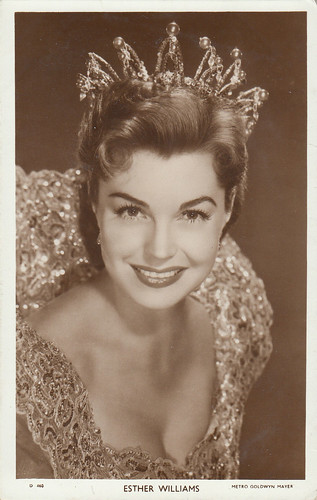
British postcard by Picturegoer, no. D 460. Photo: Metro Goldwyn Mayer. Collection: Marlene Pilaete.
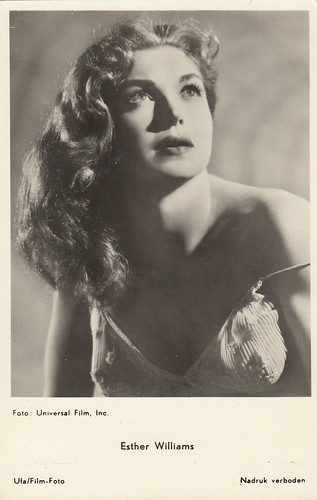
Dutch postcard by Gebr. Spanjersberg N.V., Rotterdam (license holder for the Netherlands of Universum-Film Aktiengesellschaft (Ufa), Berlin Tempelhof), no. 3397. Photo: Universal Film, Inc. Esther Williams in The Unguarded Moment (Harry Keller, 1956). Collection: Marlene Pilaete.
Text and postcards: Marlene Pilaete. Additional sources: Wikipedia and IMDb.
No comments:
Post a Comment